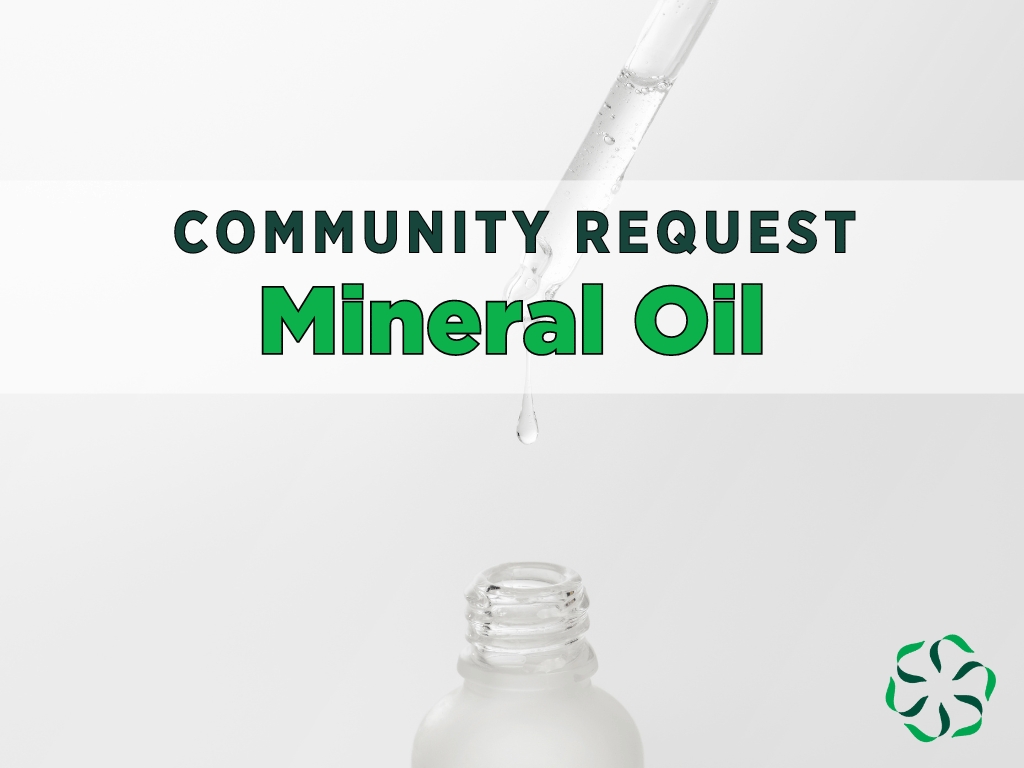In this community request, we look at mineral oil, an ingredient found in cosmetics, foods, household products, and pharmaceuticals: mineral oil.
What is mineral oil?
Mineral oil is a clear, odorless oil derived from petroleum.
When crude oil is distilled to produce gasoline and other petroleum-based products, unrefined mineral oil is produced and collected.
The unrefined mineral oil is then highly processed and purified before becoming a product that is safe for us to use in various capacities.
Keep in mind that humans have safely used petroleum-based products for centuries.
Where do I find mineral oil?
Mineral oil is generally categorized into five different types (1,2):
- Cosmetics and personal care products
- Foods
- Household products
- Industrial
- Pharmaceutical products
This post will focus on cosmetic, food, household, and pharmaceutical product uses for mineral oil.
Cosmetics and personal care products
We find mineral oil used in cosmetics and personal care products, including
- lotions
- creams
- ointments
- makeup
Mineral oil acts as an emollient and occlusive ingredient, meaning it moisturizes and creates a barrier, helping to keep our skin hydrated by preventing water loss. It is also generally non-allergenic and noncomedogenic, meaning people with sensitive skin can use the product, and it will not clog pores when used on the skin.
Foods
We find white mineral oil as a food additive ingredient used in the production and preservation of some foods, including
- bakery products
- frozen meats
- fruit and vegetable coatings
- dehydrated fruits and vegetables
- pickle brine
- candy
White mineral oil is highly refined to meet specific safety standards. It is only allowed in very small amounts as a food additive ingredient, meaning it is not allowed to be present in quantities above the regulated amount.
Household products
We find mineral oil in household products, including
- food-grade mineral oil for conditioning wood and cleaning
- Sprays designed to clean and polish wood surfaces
- Sprays designed to clean and polish stainless steel and appliance surfaces
When applied to wood surfaces, like cutting boards, food-grade mineral oil acts as a protective barrier and conditioner to prevent the cutting board from warping while remaining food-safe, unlike plant-based oils that go rancid and can harm cutting boards and other woods over time.
When included in sprays for wood surfaces and appliances, it can help restore luster and clean without harming the wood or the sheen.
Note that only food-grade mineral oil should be used on wood used for cooking (e.g., cutting boards, butcher blocks, etc.). Sprays not designed for food surfaces, such as wood polish, should never be applied to food preparation surfaces.
Pharmaceutical products
We find mineral oil used in pharmaceutical products, including
- ointments
- laxatives
Similar to cosmetics, mineral oil is used as an emollient ingredient in pharmaceutical-grade ointments. It also acts as an effective and safe laxative ingredient in some medications.
Are there different grades of mineral oil?
In general, there are four grades of mineral oil.
- Technical/Industrial Grade: Designed for use in industrial applications and may contain impurities that could have adverse health effects when ingested or used topically.
- Cosmetic Grade: Designed and purified for safe use in cosmetic products, but not safe to ingest.
- Food Grade: Designed and purified for safe use as a food contact product or further refined and purified for use as a food-additive ingredient.
- Pharmaceutical Grade: Designed and purified for safe use in medications and ointments.
Is mineral oil safe?
Mineral oil is safe to use as long as you follow the directions and use the correct grade of mineral oil for your outlined purpose (1,2,3).
For example, if you’re making a homemade cosmetic, purchase a cosmetic-grade mineral oil rather than a food-grade mineral oil to get the desired result.
Additionally, food-grade mineral oil designed for cutting boards and other food-contact surfaces is not designed for use as a food additive. Furthermore, using mineral oil in home-based cooking is not advised nor recommended.
Is there a plant-derived mineral oil?
All mineral oil is derived from petroleum sources. Manufacturers use mineral oil instead of plant-derived oils because it is safe, non-allergenic, highly stable, not prone to expiring quickly (e.g., oxidizing or going rancid) and cost-effective (1).
The good news.
Mineral oil is a versatile, safe, and effective ingredient with numerous benefits across various applications. Its safety has been confirmed through numerous studies and approval by regulatory agencies across the world.
If you have any questions about ingredients or ideas for a blog post, please send us an email or submit your idea to us at go.msu.edu/cris-idea.

